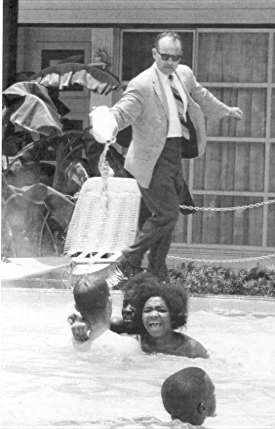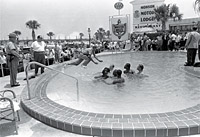The most controversial post on this entire blog and, for a while, one of the most read. It was fairly rewritten twelve-years later (2025) but see the Post-Mortem, below, to find out why.
tl;dr for this whole post? Racism is bad. Pouring acid into a pool to scare protesters is bad. Even then, rewriting the captions of horrendous imagery to try and upsell it is problematic, and sometimes plays into the very narratives you are trying to speak out against.
Note, some of the feedback I got to this post, and a few people claiming it was pro-racism, lead me to write a follow-up to the original version: Someone was wrong on the internet.

That photo depicts James Brock dumping muriatic acid on a group of protesters in 1964.
What's muriatic acid? Hydrochloric acid. Best I can tell it sometimes is called muriatic when used for cleaning. In this case, we can update the above to say "James Brock dumping hydrochloric acid..." It doesn't really matter. Acid was poured. Near people. For the reason of punishing people for protesting.
There are legit reasons to have it near a pool. It can be used to clean pool tiles. I am sure other things. There have been debates about whether the amount used that day could possibly have been harmful. Frankly, probably not. I have not done the math but that is all academic. The reason he was pouring the acid into the pool was to at least scare the protesters. Dumping {CHEMICAL} into {PLACE} to generate {STRONG RESPONSE} is not precisely the defense it might seem. One thing we know is that it did not work:

Excuse the tiny size of that one. But that's the police having to jump in later to get those same protesters out.
Before I continue, note that NPR did a later piece, the year after I wrote this. You might prefer them.
The History Behind the Photo
The photo was connected to the St. Augustine Movement, named for the town in Florida where it took place. Lots of peaceful protests and demonstrations were responded to with violence, which lead to more and more complicated protests.
On June 11, 1964, Martin Luther King, Jr was arrested for trespassing at the Monson Motor Lodge after being asked to leave from its segregated restaurant. This (and other things) helped spurn on a group a group of folk, black and white, to plan a protest. White guests invited black colleagues to join them in the pool. The end result was the above acid pour and then the slightly-less-above cop jumping in.
The NPR piece I linked describes the event, and the photo, as "largely forgotten."
What Inspired This Post
When I came across that "large forgotten" photo, it was not in the context of a coordinated protest as part of the larger Civil Rights movement. The caption had been erroneously changed to "June, 1964. Black children integrate the swimming pool of the Monson Motel. To force them out, the owner pours acid into the water." I found a few other captions closer to the truth, perhaps, but several said it was a family or implied that the group was there for non-protests reasons.
This is a photo that depicts — in low resolution by 2013 standards, sure — a group that is somewhat obviously not a group of black children. It is less obvious whether or not it is a family.
Despite this conflict between what was being shown and was being told, a lot of comments seemed to largely go with whatever story the picture was being captioned with. It was confusing to see.
[2025-10-18: To avoid naming-and-shaming and because we are talking about a twelve-year-old post, I have removed any links/etc to examples. You can doubt what I say, that's ok.]
One realizes that had the caption said a pro-Brock thing — "Hotel owner defends his rights against criminals" — then that would flavor the image in a whole other way. Or you can strip details entirely and suggest a fiction with just a few words: "Tony Smith pours ice water into a pool to help cool off swimmers in historic 1967 Tampa heat wave!"
As vital as the truth is, the shape and mechanisms of the internet are making it hard to track back to that truth.
While a degree of social currency can be used — upvotes, downvotes, comments, shares — it can rarely keep up with a concentrated attempt to recast an event into a specific light. By the time corrections are written, if written, and apologies made, if made, the great ever marching machine has moved on to the next ephemeral thing.
So much of our reality is predicated on the way we place things in context and the internet-as-a-whole has far too few safeguards to properly adapt to human inventiveness.
Then, when safeguards are made, they are potential weapons against the truth. Billions of people in a digital space where the honor system is the only real protection. It is, honestly, terrifying.
Why Make Monsters When History Made Plenty of Its Own?
Going back to the photo, imagine seeing it. Build a context around it.
Here's my context: Protesters risk safety and personal freedom to make a stand. An owner, likely feeling justified because much of society said it was his right, pours acid into his pool. Onlookers might have take sides, but based on how folk act nowadays, I'd be willing to bet most took it as spectacle.
You have this powerful photo showing a desperate man resorting to a terrible act because his power was crumbling. He chose violence because his words were insufficient. We later know his violence failed and the law was called into the enforce the status quo. At the moment, though, this was his great rebuttal to racial equality: muriatic acid.
Even to what degree the protesters lost that day, they won.
And for all that, they and Brock were, "largely forgotten."
Think about what would make someone see a this photo and then lie by saying that it was children. Maybe not the poster I saw. Or the poster they saw. But along the way someone knowingly stripped context bit by bit to make it more clickable.
Why make monsters when history makes plenty on its own? This was not some dingy small pool in the middle of nowhere. There was a crowd. Families. Reporters. Police. Think about all these moving parts and the horrible truth of them: these protesters were ultimately up against institutionalized racism from people that were probably really nice to their pets and had loving parents and good, church-going children and, more importantly, thought of themselves as morally upright citizens doing the right thing for their society.
Because context matters and when your personal context allows for such racism — or homophobia, transphobia, etc — you will see yourselves as always right. Even when the only rebuttal you have is muriatic acid.
Until someone comes along and rewrites your history to get more clicks and likes. Which ironically opens up the gates for people to decry not racism itself but claim it was mostly taken out of context. This last bit I saw firsthand when this post was used out of context to try and discredit correct captions for the photo later posted.
Popular history, as it turns out, is written by the storyteller. And sold to the uninterested by The Algorithm.
More Recent Articles (to the 2013 original)
Two recent (to the 2013 original) articles from a local paper, to get a somewhat contrasting view (from each other):
- Civil rights trailblazer returns to historic site
- Hotel owner Brock dies (Backing up the claim that history is closer than we realize, Brock did not die until 2007)
Post-Mortem, 12-Years-Later
In a lot of ways when I kept thinking about updating this blog, this post kept surfacing in my head as justification to perhaps just delete the whole site. I'm glad I didn't.
To start from a place of honesty, here is the archive of the more poorly written original [Wayback Machine]. There are some obvious typos. Some obvious "both sides" takes. It's not very good. Spends too much time talking crap about Tumblr. It argues for the same basic points but took a different path. It buried the lede a lot more. It left room for interpretation.
After posting it, there were three basic waves of response no including the initial time it took people to even notice it:
- People finding it and discussing the historical aspects, suggesting fixes, and generally being interested.
- People starting to use it in online posts about the photograph which were incorrect.
- People starting to use it to try and perhaps claim the growing number of correct uses of the photo were being overblown.
In other words, people were beginning to share it to try and argue that Brock was right. Using my post. Which caught me off guard. To my deep discredit, I barely responded to this fact. I was increasingly anxious by how much the post was being linked but also anxious with saying anything. I just kind of ignored it, hoping it would speak for itself. I was wrong.
Eventually, in 2015, someone found it and called it out for trivializing racism. Maybe it does, because it spent more words arguing about bad online posts than the racist event that inspired them. I ended up rewriting the original a bit, then lied and said I didn't while posting Someone Was Wrong on the Internet. I still feel a bit justified for that second rant, though I kind of wish I had never written it.
There is a relationship between the reader and the writer and in that relationship there are failures on both parties to meet half-way.
Years after anyone has really cited my post — (a) a lot of online discussion of the incident seems to be more factually true and (b) the blog got out of date enough it is nowhere near the top result for things for which it used to be considered useful — I am returning and fixing some things.
I moved the photo to the top and started out with an explanation. I took some of the more flippant parts out — the original had the bad-context sample reference Bill Murray for some damned 2013-era Doug reason — and tried to overall make every single point more clear to my stance.
I know there is nothing I can do to guarantee anyone reads this is the way I intended, but I felt that I should at least try.

